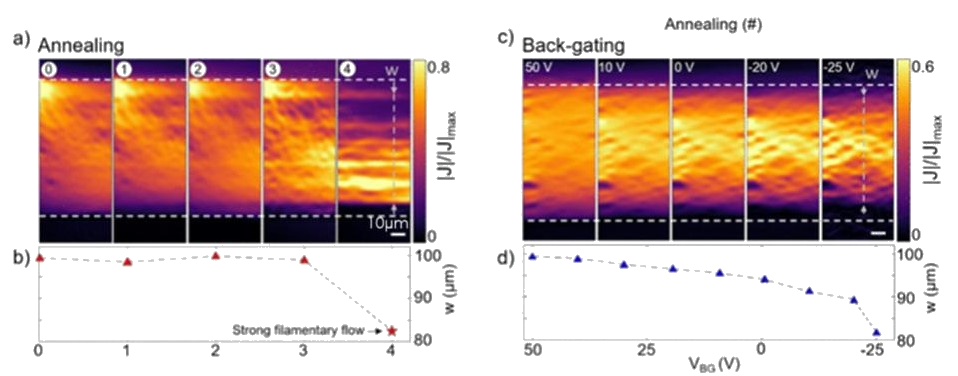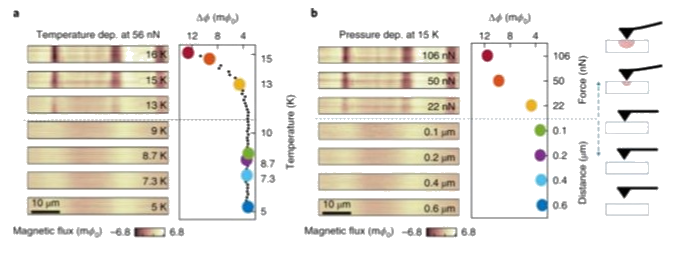Multiferroicity in plastically deformed SrTiO3
Inducing multiple ferroic orders in quantum materials is pivotal for advancing quantum technologies. We demonstrate that plastic deformation introduces robust magnetism in the quantum paraelectric SrTiO₃, observable in both conducting and insulating samples. Local magnetic imaging indicates that this magnetic order localizes along dislocation walls, coexisting with polar order. Notably, external stress can switch these magnetic signals on and off, establishing plastically deformed SrTiO₃ as a quantum multiferroic. This work positions plastic deformation as a versatile tool for engineering quantum material properties.

Nature Communications 15, 7442 (2024)
Current mapping of amorphous LaAlO3/SrTiO3 near the Metal–Insulator transition
The 2D electron system at the LaAlO₃/SrTiO₃ interface exhibits tunable physical phenomena. We employed scanning SQUID microscopy at 4.2 K to image current distribution in amorphous LaAlO₃/SrTiO₃, adjusting carrier density via electrostatic gating and oxygen annealing. Our observations show that potential disorder influences current flow, with homogeneous 2D conduction evolving into parallel channels as the system approaches the metal-insulator transition. This behavior is linked to ferroelastic domains and oxygen vacancies, offering insights for designing micro- and nanoscale devices with low carrier densities.

ACS Applied Electronic Materials 2022
Current mapping of amorphous LaAlO3/SrTiO3 near the Metal–Insulator transition
In systems near phase transitions, macroscopic properties often follow algebraic scaling laws, determined by the dimensionality and the underlying symmetries of the system. The emergence of such universal scaling implies that microscopic details are irrelevant. Here, we locally investigate the scaling properties of the metal-insulator transition at the LAO/STO interface. We show that, by changing the dimensionality and the symmetries of the electronic system, coupling between structural and electronic properties prevents the universal behavior near the transition.

Strain-tunable magnetism at oxide domain walls
Applying stress to ferroelastic materials like SrTiO₃ induces nonlinear strain responses, leading to the formation of domain walls with distinct orientations. These domain walls exhibit strain-tunable polarity and enhanced conductivity. Our research reveals long-range magnetic order along these ferroelastic domain walls in SrTiO₃ and related heterointerfaces. Using scanning SQUID we observed striped magnetic patterns corresponding to these domain walls. In conducting interfaces, this magnetism couples with itinerant electrons, as evidenced by magnetotransport measurements. This study highlights the potential of manipulating domain wall magnetism through strain, offering avenues for nanoelectronic device applications.

Applying local pressure to image and tune SrTiO3 domain wall polarity
We measure the voltage of a LaAlO3/ SrTiO3 (LAO/STO) sample as a function of local pressure. We found that the pressure we apply has very strong response on the STO domain walls. Using simultaneous temperature dependent scanning SQUID measurements and computer simulations we realized that this response has to do with STO domain wall polarity that is pressure tunable. We also understand now that the origin for the current stripes we previously observed is this domain wall polarity.

Anisotropic transport at the LaAlO3/SrTiO3 interface explained by microscopic imaging of channel-flow over SrTiO3 domains
The current density at the LAO/STO interface is modulated over STO domain walls. Here we show that these modulations are significant to the global electrical properties of the interface. The figure shows two measurement configurations on a square pattern. If the sample was homogenous there would not be any difference between the two measurements. But in this case we see stripy modulations. If the current is injected along (Vertical) the stripes the resistance of the interface can be up to 4 times smaller than the other direction perpendicular to the stripes (Horizontal).

Applied Material & Interfaces (2016)
Journal of Superconductivity and Magnetism (2015)
Locally enhanced conductivity in LAO/STO due to STO domains
The ability to control materials properties through interface engineering is demonstrated by the appearance of conductivity at the interface of certain insulators, most famously the {001} interface of the band insulators LaAlO3 and TiO2-terminated SrTiO3 (STO). To better understand the interface conductivity, we used scanning SQUID microscopy to image the magnetic field locally generated by current in an interface. At low temperature, we found that the current flow was modulated over narrow paths oriented along the crystallographic axes. The configuration of these paths changed on thermal cycling above the STO cubic-to-tetragonal structural transition temperature, implying that the local conductivity is strongly modified by the STO tetragonal domain structure.

The structural domain walls of STO move under the appliance of electric fields. The images below show the same location of the sample under 4 different back gate voltages. It is apparent that domain wall on the right becomes longer and then shorter again when the voltage is set back down to zero.

Critical thickness for magnetism in LAO/STO
LaAlO3 and SrTiO3 are two non-magnetic insulating materials. After growing at least 4 unit cells of LAO on a STO substrate, the polar/nonpolar interface exhibits a number of interesting properties including a high mobility 2D conductivity, superconductivity below 100 mK, magnetism and an electric field-controlled metal-insulator and superconductor-insulator transition. We found that there is a critical thickness to the magnetism in this material, which means that the electronic reconstruction is essential for the magnetism. At the same time we found that disorder plays an important role in inducing the magnetism.

With: Kathryn Moler, Harold Hwang @Stanford
Tuning the magnetism in LAO/STO
We are trying to learn more about the microscopic nature of this magnetism by tuning it in different ways. For example we found that local strain manipulates the ferromagnetic patches in LAO/STO. The images below show repeated scans of a small group of ferromagnetic patches that change as a result of local strain we apply with the tip of the SQUID’s chip. Scanning Probe Manipulation of Magnetism at the LaAlO3/SrTiO3 Heterointerface

With: Kathryn Moler, Harold Hwang @Stanford






